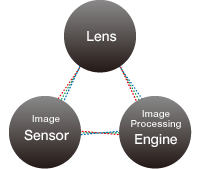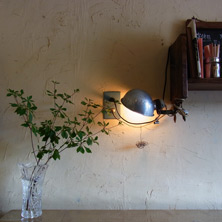Inside Story

*Posted on: December 15, 2010
- Planning
- Design and Development
- Sales and Marketing
The goal is “Ricoh Pure Image Quality Technology E/span>

“We sought both low noise and high
resolution for low-light scenes.
(Yoichi Kakuta)
It has been said of Ricoh digital camera image quality that “at first glance is appears modest, but the image quality has a depth that excels. EIt is this “pure image quality capturing what is perceived by the naked eye Ethat impresses people. “Image quality true to what is perceived by the naked eye has been our fundamental image quality concept ever since the first development of digital cameras, and this natural descriptive power has been realized through three core technologies: the lens, the image sensor, and the image processing engine, Eexplained Yoichi Kakuta of the Personal Multimedia Company ICS Design Office.
Take bright light captured with a low-distortion lens and convert it into an electrical signal with a back-illuminated CMOS sensor (image sensor) that can brightly reproduce even low-light scenes. Then use the image processing engine Smooth Imaging Engine IV to produce the final high-resolution image utilizing processing to eliminate noise, correct colors, covert the data format, etc. These three technologies are collectively called Ricoh Pure Image Quality Technology. “A major characteristic of this technology is that it can produce images that have high resolution but low noise, Esaid Kakuta.

Ricoh Pure Image Quality Technology
Wider range of tone gradations in dark scenes
“Of all of our objectives, the one with the highest priority was ‘image processing capable of producing images with low noise and a wide range of tone gradations in shadow areas even when photographing dimly lit scenes without a flash,’ Esaid Kakuta. The reason for this priority was the results of general-user camera satisfaction surveys. Year by year, overall satisfaction has risen, but many users are still dissatisfied with respect to shooting in dark places.
When shooting in places that are a little dark, you tend to end up with colors that are not there in reality (false colors). These false colors are known as noise. “When noise is uniformly removed, you tend to end up with a flat, dull image, but we are doing the signal processing in a way that reduces noise while maintaining the natural resolution as is, Eexplained Kakuta. This signal-processing knowhow is one of the core technologies of Ricoh.
Fine tone gradations even in dark areas
Actual size (2977K)
f=28mm 1/45sec F3.5 ISO100 Exposure compensation: 0.0
“We really struggled over the balance between resolution and noise reduction, Esaid Kakuta. Depending on the scene, you sometimes want the feel of crisp resolution even if you have to ignore some noise. “Our solution was to let the users themselves decide the balance by giving them five noise processing options to select from: Off, Auto, Weak, Strong, and Max. E/p>
- Planning |
- Design and Development |
- Sales and Marketing


